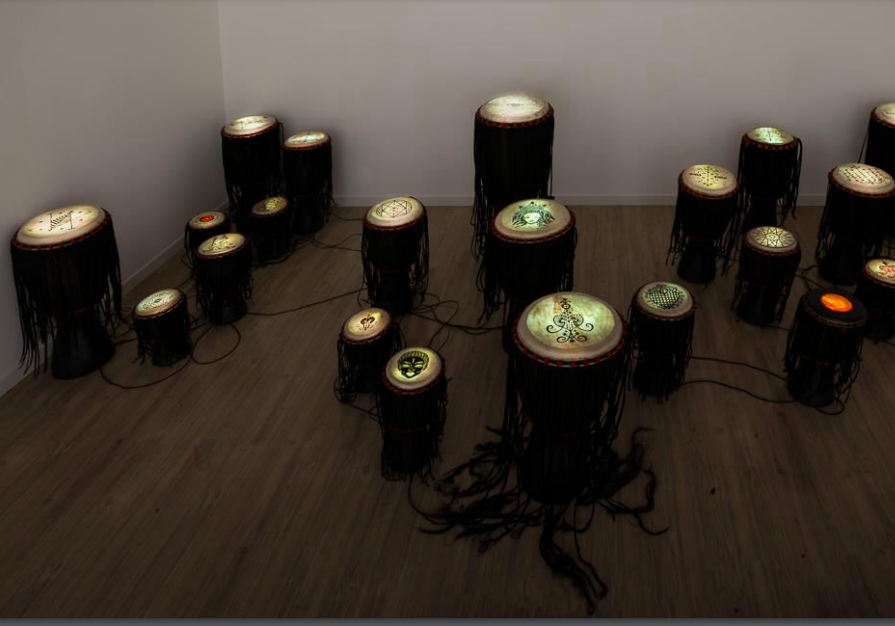
THE JOURNEY OF ERZULIE
DIMITRI FAGBOHOUN
THE JOURNEY OF ERZULIE
DIMITRI FAGBOHOUN
6 février - 14 avril 2020
OFFICINE DEL IMAGINE, Milan
Une proposition curatoriale de Silvia Cirelli
Rédaction du texte par Charlotte Lidon
Following his research on the intangible and the spiritual, which in the eyes of Dimitri Fagbohoun coexist in everything, the artist brings us with him on a journey alongside the goddess Erzulie, whose lwa(1) he invokes during this exhibition.
Heir to a dual culture, Beninese and Ukrainian, for the past ten years Fagbohoun has been exploring the different facets that have helped shape his identity. He draws from his own syncretism, nourished by beliefs drawn from the great monotheistic religions, but also from Voodoo and traditional African cultures.
If he is interested today in the figure of Erzulie, a venerated muse worshiped on several continents, it is to apprehend the diversity of the representations of which she is the subject, according to the times and the geographical places in which she appears. Guardian figure of Haitian voodoo, the goddess Erzulie indeed appears in multiple forms.
Coming from Dahomey, the ancient kingdom of Benin, the original voodoo, voodoo, vodun or vodun is inherited from the beliefs of the Fon, Ewe and Yoruba tribes of the animist tradition. It developed beyond African borders, including South America, the Caribbean and North America, where it came in contact with white slaveholders and their Christian iconography from which he often borrows attributes.
Erzulie, of which there are fifty-one different representations in Haitian voodoo, is thus often personified in the guise of the Virgin Mary - Mater Dolorosa.
Heiress of the ancient goddesses, she was venerated in Sumer under the name of Astarte, then Ishtart and Inanna in ancient Mesopotamia. She is credited with many powers, the most common of which are linked to love, desire and fertility. Erzulie Freda, Erzulie Dantor, Erzulie Grânn; Erzulie Gé rouge; Erzulie Mapyang; Erzulie Kaoulo are some of the many names lent to the goddess that correspond to character traits and particular identifications given throughout the ages by the faithful.
Personified by her hair or invoked by the silent sound of drums, the scenographic device set up by the artist allows the spectator to walk to meet the goddess, whose multiple faces they discover at the same time as they move through temporalities, geographies and multiple belief systems.
The representations he creates thus highlight the importance of history in the process of identity building. He reminds us that the representations of Erzulie Dantor include the iconography of the Black Madonna of Częstochowa, whose icons were brought back by Polish soldiers during the Haitian revolution in 1802. Following this historic path, his Microcosmos series (2)- which explores iconic corpora of African statuary, objects of worship, or tools of communication with ancestors - might as well refer to the symbolic presence of spirits and to the multiple metamorphoses of Erzulie.
It should also be noted that popular fervor recognizes the goddess through her signifiers, known in the Voodoo world under the name of Vèvè(3), each of which corresponds to a particular lwa, the surfaces of which the artist covers with evocative layers. Known throughout the world, their magical religious symbolism can be found in the oldest records of human civilization in the form of pentacles, amulets and talisman. If in Voodoo everything is a symbol, the ritual is its very essence. Through ritual, the mysteries of the universe may or may not be revealed during the ceremony. The study of the invisible has been present in the artist’s work for many years. In 2011, the video Ayiti, Le chant de mars(4), raised the question of the relationship to the divine, to faith, and to the hope it provides. A few years later, in 2015, the film Adiyo5 showed us the artist engaging with the invisible during a Fa6 session with a Bokono (clairvoyant). Performed in Benin, this type of divination is one of the fundamentals of the Voodoo religion. Once again, Erzulie's study allows the artist to question the transmission of beliefs and the passing on of knowledge. To establish communication between the world of the living and that of the spirits. This new body of work which studies the Gods and their rites is a continuation of his work from Papa Was A Rolling Stone(7)to Mama Dao8, two opuses within which he questioned the world of the living and that of the dead.
Here
Erzulie is alive,
Erzulie is clairvoyant
Erzulie is white,
Erzulie is black,
Erzulie is Water,
Erzulie is Fire,
Erzulie is Earth,
Erzulie is Air
Erzulie comes from the crossbreeding of history and questions our perceptions and our relationships with the invisible.
Notes:
1. In the animist religions the lwa représents the spirit that serves as an intermediary between the creator Mbamawu and the humans. He is the incarnation of God and visible in many forms.
2. Body of work began in 2017
3. A Vèvè is a symbol used by Voodoo priests. To each Vèvè corresponds a particular Lwa.
4. Video 3’15, 2011
5. Video, 16’, 2015
6. Fa is the name given to the art of divination in the Fon culture. This name takes its origin in the City of Ifé in Nigeria, where according to tradition, the divination of Fa first appeared.
7. Video 8’25, 2011 8 Body of work including different works gathered under the name of Mama Dao, 2014-2015

© courtesy de l’artiste
© courtesy de la galerie





